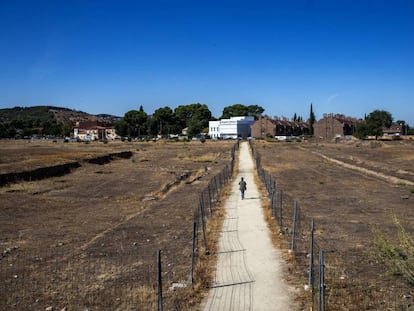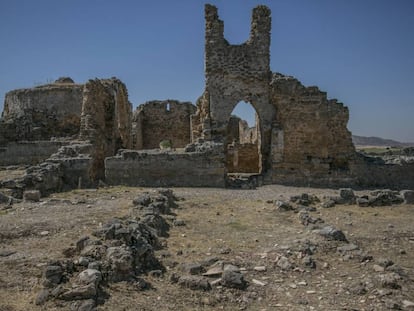Inside Toledo’s Visigothic city
Researchers have discovered that what was thought to be the remains of a church at Los Hitos archaeological site is in fact a sixth-century palatine complex


The work of a hundred scientists, historians and archaeologists from universities and research centers in Spain, the United Kingdom and Germany, is shedding new light on the archaeological site known as Los Hitos, in the central Spanish province of Toledo. What began a century ago as a quarry from which locals would take stones to build and repair their houses has been revealed to be the remains of a fortified palatine complex from the Visigothic period – not a lone church, as was once thought.
After three years of work, experts have concluded that the enclave is of “enormous importance,” bringing new meaning to the 7th-century town, which is surrounded by walls and turrets. The complex was located 30 kilometers from the Visigothic capital of Urbs Regia and included palaces, churches, houses, drainage systems, store houses and farming areas. The translation on one of the tombstones found in the dig has clearly indicated that it was built by a monarch whose name ended in the letters “do.”
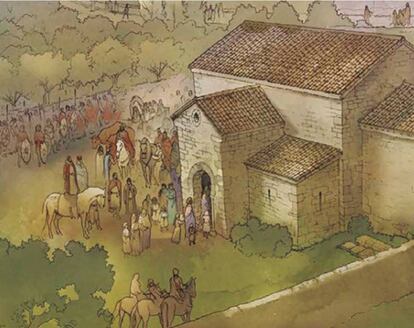
“It was like a small Récopolis,” says Jorge Morín, director of the research, in reference to the impressive city that Visigothic King Liuvigild ordered built in Zorita de los Canes, in the eastern Spanish city of Guadalajara, in honor of his son, Recaredo.
Los Hitos was discovered more than a century ago, and has been the subject of a wide range of interpretations. Locals had been using stones they found on the site to fix up their homes for decades, and even opened up tombs to sell their contents. This prompted the Spanish Republic’s Artistic Treasures Committee, an organization set up to seize and protect Spain’s cultural patrimony, to complete the first study of the site in February 1938, right in the middle of the Spanish Civil War.
However, all attempts at conservation were abandoned until 2016, when the archaeological consultancy firm AUDEMA and the Institute of Archaeology at University College London, reopened the site, under the joint direction of Isabel Sánchez Ramos, and with the support of the Orgaz city council and Toledo provincial council. This is when the work took an unexpected turn.
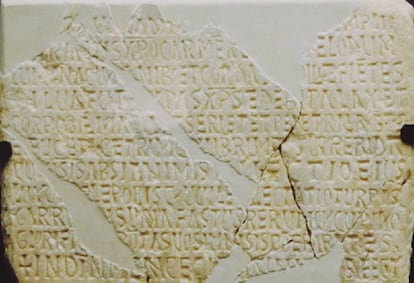
Excavations began again last summer in collaboration with a number of universities, including Madrid’s Complutense University, Córdoba University, San Pablo CEU University, Madrid’s Politécnica University, Newcastle University in the UK, and Cologne University and Marburg University in Germany, as well as the Spanish Geological and Mining Institute. Three years ago, they realized that what archaeologists had supposed were the remains of a church in 1938, were in fact an aristocratic pavilion almost 11 meters tall, with a stairway leading up to a second floor.
The following year they found a church with a burial place in the nave in front of the choir. Later, they discovered other tombs in the south doorway, as well as an adjacent pantheon, which held the body of a man who was possibly a dux – an important member of the nobility. So far, analysis has determined he was a man of advanced age with bowed legs due to the amount of time he spent on horseback. It is thought he was probably buried with weapons and other valuables, which were plundered during the Moorish invasion. In 711, the complex was taken by the Arabs, who did not destroy it but rather changed it to suit their needs, turning the space into a kind of communications hub.
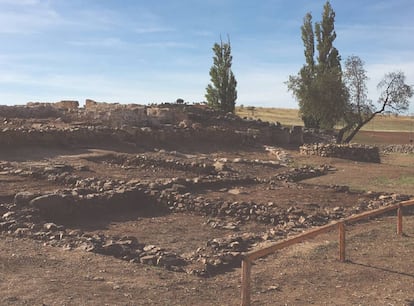
Hundreds of sculptural pieces have also been recovered from Los Hitos and are collectively considered to be the most important find from the Hispanic Gothic period. One of these pieces consists of a long inscription from a spiritual poem. It has been translated by professor Isabel Velázquez from Madrid’s Complutense University and ends in the phrase: “Built by …do.”
This last verse directly connects the building with a Visigothic king, which has triggered high hopes among the archaeologists. “We don’t yet know [if it belonged to a monarch] because we are in the first phase of the investigation, but we will find out,” says Morín.
In 2018, another building was located with two small doorways and a central hall, which means a new palatine construction went up toward the end of the sixth century or the start of the seventh. This building was occupied again in the 10th and 11th centuries and adapted, as was the church, which the Moors turned into a mosque. Morín explains that it indicates that urban planning was based on Pythagoras’s squares, undermining the theory that the complex was built at random and then added to.
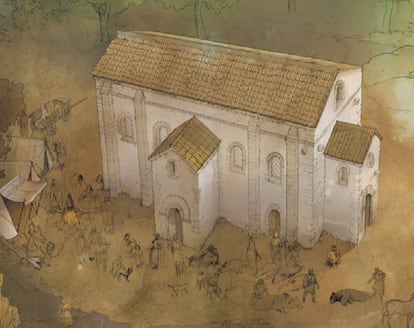
This year, a wall two- to three-meters thick with rectangular turrets has been unearthed, and which the experts believe belongs to the period between Theudis (531-538) and Recaredo (586-601). Surrounding the entire town, the wall had a huge gate and adjoining warehouses and homes of around 20 square meters with a back courtyard. “Besides offering protection, the wall conferred prestige indicating palatine status along with the marble that was used in its construction,” says Morín.
English version by Heather Galloway.
